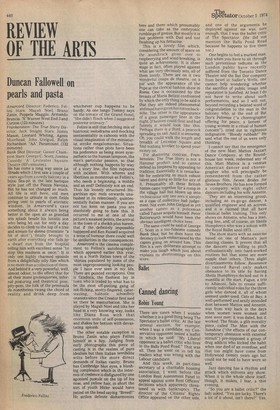Ballet
Canned dancing
Robin Young
There are times when I wonder whether it is a good thing being The Spectator's ballet critic. At the last general election, for example, when I was a candidate, my Conservative opponent issued a leaflet in which he said: "My Liberal opponent is a ballet critic who lives in the Balls Pond Road." That was all. Then he went on to tell his readers what was wrong with the Labour candidate.
And this week, as part-time secretary of a charitable housing association, I went before the London Rent Assessment Panel to appeal against some Rent Officers' decisions which apparently threatened us with bankruptcy. The director of the Citizens' Rights Office appeared on the other side, and one of the arguments he deployed against me was, sure enough, that I was the ballet critic of The Spectator. (He did not mention the Balls Pond Road because he happens to live there too.)
One begins to feel a marked man. And when you have to sit through such pretentious tediums as the London public have recently suffered from the Toronto Dance Theatre and the Bat Dor company from Israel 'at Sadler's Wells, one cannot help wondering whether the sacrifice of public image and reputation is justified. At least I do not have to write about such performances, and so I will not, beyond recording a belated word of congratulation to the man in the balcony who, at the end of Bat Does Palornas ("a choreographic offering for peace, a lament of young women in a ritual of human concern"), cried out in righteous indignation: "Bloody rubbish!" He said what the rest of us were only thinking. I cannot say that the emergence of the new Matt Mattox Jazzart Dance Company, at the Roundhouse last week, redeemed any of this. Matt Mattox is a veteran American dancer and choreographer who will principally be remembered from the rather glorious film. Seven Brides for Seven Brothers. He has now formed a company with eight other dancers including his wife Annette.
'They are an interesting group, including an ex-go-go dancer, a qualified engineer and an actress, and it is claimed that all have classical ballet training. This only shows on Annette, who has a lean, long line, and, of course, on Sheila Humphreys who was a soloist with the Royal Ballet until 1973.
The show starts with an exercise based on one of Mattox's jazz dancing classes. It proves that all the dancers are willing to pitch enthusiastically into -hard-worked routines but that some are more supple than others. Three slight divertissements follow. Reverence to canned Ravel only makes obeisance to its title by having Sheila Humphreys decked out in a mantilla at the start. Fugue, a trio to Albinoni, fails to create sufficiently individual roles for the three girls who danced it, all of whom seemed under-used. Cats at Bay, a well-performed and sexily intended duet between Mattox and Annette, was from way back in the days when women were women and men were men: it was dated, but it worked. The finale, a glib morality piece, called The Mon with the Sunshine ("the effects of our contemporary obsession with external stimuli") pre-supposed a group of drug addicts who kicked the habit when one died of an overdose, and that too might have come from Hollywood twenty years ago but could not be said to have worn so well.
Jazz dancing has a rhythm and attack which enlivens any show. When it is the whole show itself, though, it makes, I fear, a thin evening.
"So you are a ballet critic?" the lady asked. "You are lucky. There's a lot of it about, isn't there?" Yes, there is with the Northern Dance Theatre in Croydon, the Frankfurt company in Birmingham, and the Royal companies returning this month. I even thought, as I watched the Conservative canvassers chasing across the green lawns, that you could make a nice ballet out of that. The ballet critic's revenge. But the most amusing Pirouette I have seen for a long time was performed by Lomie, the girl gorilla at London Zoo, I cannot think that even my Conservative oPponent could have matched it if he had been dancing in person.

































 Previous page
Previous page